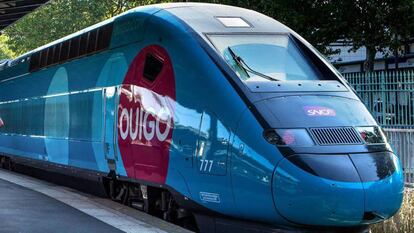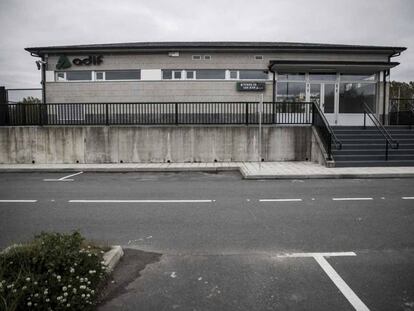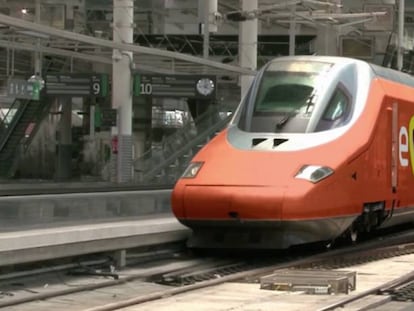Could France’s state rail operator bring “low-cost” train travel to Spain?
Ahead of the imminent opening up of domestic high-speed networks to other European Union operators, SNCF is planning to have a Spanish service in place by 2020

Trains with more seats and that run for more hours every day. Doing away with all services apart from those that are strictly necessary and that do not compromise safety. More flexible ticket prices, adapted to the needs of groups such as families, young people and seniors. Minimizing costs until a high-speed train ticket costs around half of what it cost under the traditional model. This is the model that the French rail firm SNCF has successfully implemented in its country, and that it now wants to export to Spain.
The state-owned rail company had already expressed its interest in competing with its opposite number in Spain, Renfe, in the Spanish high-speed rail market. But now the operator has given away more clues as to how it plans to do so by December 2020, when domestic rail markets in the European Union will be opened up to competition from other countries.
The number of high-speed train journeys taken by French passengers has increased from 100 million to 120 million
At a meeting last month in Spain with the press in Madrid, SNCF’s head of long-distance rail, Rachel Picard, hinted at the plan they are considering, running through the successful launch six years ago of Ouigo, its low-cost brand, which was clearly inspired by the model successfully implemented in the airline sector by firms such as Ryanair and easyJet.
Picard narrated a story of success: how the launch of these cheaper trains has benefited everyone, boosting the number of passengers in a sector that appeared to have stalled. As well as increasing the number of high-speed train journeys taken by French passengers from 100 million to 120 million, Ouigo has also managed to turn a profit in a short period of time, she claimed.
The French executive had words of praise for the Spanish high-speed AVE service, which she described as “a dream, one of the best in Europe.” But she stressed that it continues to be a model that is focused principally on business travelers or those with a high disposable income. And she supplied a figure to demonstrate the margin for growth that high-speed rail still has in Spain: while in the Spanish market the average number of kilometers traveled per passenger is 500, in France that figure is as high as 1,200 kilometers. “I’m not saying that [the AVE] is expensive for the good service it provides. But a cheaper service is possible,” she added, drawing a parallel between the AVE and its French counterpart, the TGV. The gap in the market, she suggested, could be filled by a Spanish version of Ouigo.
SNCF wants to come to Spain to stay and is not willing to sign a deal that would be unsatisfactory in the long term
Picard was optimistic throughout about the current state of rail. “The deregulation of the sector is good for everyone,” she repeated, including in that “everyone” Renfe, which is currently the sole operator in Spain’s rail market when it comes to transporting passengers. But she also revealed some of the difficulties that SNCF is facing were it to enter the Spanish high-speed market.
On the one hand, there is the search for a local partner. The French firm is planning to enter the market in conjunction with Spanish firm Ilsa – an affiliate of infrastructure and renewable energy firm Acciona – and regional airline Air Nostrum. But it doesn’t seem to have nailed down that agreement. “That’s what we want to do,” Picard explained. “But if we don’t reach a satisfactory deal we could come alone.” In the background is the importance of what the company has designated “balance in governance.” In a venture such as this one, in which SNCF is willing to invest a large amount of money with a view to staying in the market in the long term, it is important to remember their experience in Italy. They entered into that market with local partners and just 20% of the capital. And in the end, they abandoned the project.
Are the French planning to lead the project with Acciona? Picard would not be drawn on that. But she did say that SNCF wants to come to Spain to stay and that it is not willing to sign a deal that would be unsatisfactory in the long term. “It’s not just with Acciona,” she added, showing that the French are not ruling out any scenario and that they could enter the Spanish market together with another company.
The other big doubt is whether the company would have trains available to enter into service in December 2020. Picard completely ruled out the possibility of leasing the necessary equipment, but did not clarify whether the firm would buy trains outright or bring them in from France. But she was unequivocal about their plans to offer a service as soon as possible. “Being the first is always a factor of success,” she said.
“Renfe would make money from the very first day”

In response to news about SNCF’s plans to enter the Spanish market, the chairman of state rail firm Renfe, Isaías Tabóas, said last month that the low-cost AVE high-speed service that his company is preparing would be profitable from the very first day of operation.
“It couldn’t have losses, it would have the profits needed to sustain the service,” he explained at a business breakfast. “It would have a margin, albeit a small one, and would make money, albeit not much, from the first day, in contrast to Ouigo, which seems to have been losing money for seven years.”
Those claims were in contrast to the statements made by Rachel Picard, who stated that Ouigo is profitable after six years of operations.
Renfe, for its part, wants to convince people to choose their new low-cost service instead of opting for car or bus journeys. “Our objective is to target the five or 10 national routes where we operate with the AVE and where the car is used more than the train,” explained Tabóas.
English version by Simon Hunter.
Tu suscripción se está usando en otro dispositivo
¿Quieres añadir otro usuario a tu suscripción?
Si continúas leyendo en este dispositivo, no se podrá leer en el otro.
FlechaTu suscripción se está usando en otro dispositivo y solo puedes acceder a EL PAÍS desde un dispositivo a la vez.
Si quieres compartir tu cuenta, cambia tu suscripción a la modalidad Premium, así podrás añadir otro usuario. Cada uno accederá con su propia cuenta de email, lo que os permitirá personalizar vuestra experiencia en EL PAÍS.
¿Tienes una suscripción de empresa? Accede aquí para contratar más cuentas.
En el caso de no saber quién está usando tu cuenta, te recomendamos cambiar tu contraseña aquí.
Si decides continuar compartiendo tu cuenta, este mensaje se mostrará en tu dispositivo y en el de la otra persona que está usando tu cuenta de forma indefinida, afectando a tu experiencia de lectura. Puedes consultar aquí los términos y condiciones de la suscripción digital.











































